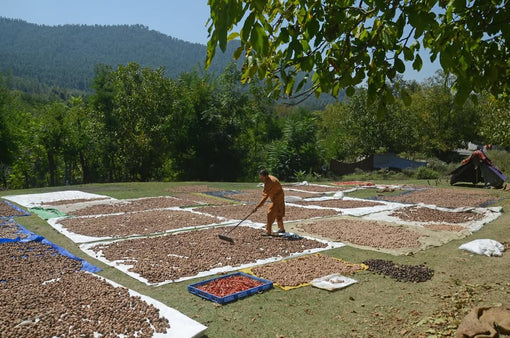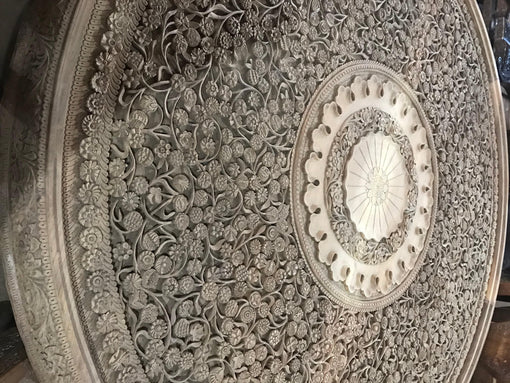
- Article published at:
- Article author: Hamiast Global
- Article comments count: 0
Drawer menu

The vibrant and intricate art of crafting Kashmiri turquoise, known locally as Ferozi, is a mesmerizing tradition that embodies the rich cultural heritage of Kashmir. However, this craft now teeters on the edge of extinction, with only a handful of artisans striving to keep it alive. From its intricate techniques to its historical significance, Kashmiri turquoise craftsmanship is a story of resilience, beauty, and the undying passion of a few dedicated souls.
The name Ferozi derives from the stunning oceanic blue hues that define the craft. This art form involves embedding precious stones, such as Ladakhi Pashm or Hakkih, onto a base of copper, bronze, or silver. The stones are intricately shaped, polished, and painted in varying shades of turquoise, creating a striking visual appeal. Sometimes, artisans incorporate real rubies and sapphires to enhance the opulence of their creations.
Traditionally, turquoise artistry found its expression in exquisite jewelry, decorative vases, ashtrays, and artifacts. The process is labor-intensive and requires exceptional skill, patience, and dedication, as each piece undergoes multiple stages of heating, shaping, and painting to reveal its unique brilliance.
Kashmiri turquoise art was once a flourishing craft, deeply admired both locally and internationally. Artisans from the Fateh Kadal area in Srinagar recall a golden era when nearly 50 families were engaged in this trade. Tourists and collectors eagerly sought these intricate creations, providing artisans with a steady income.
However, the allure of modern professions, combined with a lack of institutional support, has driven many artisans away from this craft. Today, only five families in the valley continue to practice turquoise art. Despite their unmatched expertise, their pleas for government assistance have largely gone unanswered, leaving this exquisite art form on the brink of extinction.
To combat this decline, Hamiast.com has taken a proactive role in reviving this centuries-old craft. By collaborating closely with the remaining artisans, Hamiast seeks to preserve the tradition and introduce it to a global audience. Through initiatives like artisan training, resource allocation, and market expansion, Hamiast is striving to give Kashmiri turquoise the recognition and sustainability it deserves.
The creation of Kashmiri turquoise involves meticulous craftsmanship, combining traditional methods with artistic finesse. Here’s how artisans like Ubaid, one of the few remaining torchbearers of this tradition, bring their creations to life:
The process begins with a coppersmith or silversmith crafting the base mold in the desired shape, whether it’s a vase, ashtray, or piece of jewelry. This blank canvas is then handed over to the turquoise artisan for the real magic to begin.
Artisans prepare laach, a black viscous substance made by mixing riverbank sand with mustard oil and heating it into a tar-like consistency. This mixture is evenly spread over the heated base using tweezers (Hindish). Though initially unappealing, this coating forms the foundation for the turquoise embellishments.
The raw Pashm stones, sourced from Ladakh, are creamish-green in their natural form. Heating them transforms them into brilliant white stones, which are then hammered into small pieces, ready for embedding. Each stone’s size and shape are carefully chosen to fit the design.
Using tweezers, artisans embed the heated stones onto the hot laach-coated base. This step requires precise temperature control to ensure the stones fuse seamlessly with the coating.
The stones are painted in mesmerizing shades of turquoise, ranging from light to dark blue. This step breathes life into the piece, as the vibrant hues transform the embedded stones into an artistic spectacle.
Molten wax is applied to eliminate imperfections, followed by smoothing the stones with a specialized tool called Khahrin. This delicate process requires great care, as excessive pressure can dislodge the stones.
Finally, the piece is varnished to enhance its luster and durability. Occasionally, artisans repaint the stones to intensify their turquoise brilliance, resulting in a finished product that captivates the beholder.
Amid the challenges facing this craft, Hamiast.com has emerged as a beacon of hope for artisans. Committed to preserving and reviving Kashmir’s cultural heritage, Hamiast collaborates with skilled craftsmen to ensure their work reaches a broader audience.
By offering financial and logistical support, Hamiast empowers artisans to focus on their craft without the burden of economic insecurity. The platform also provides them with a space to showcase their creations to collectors and enthusiasts worldwide, ensuring that Kashmiri turquoise regains its rightful place in the global market.
Through campaigns that emphasize the cultural and artistic value of this tradition, Hamiast is actively raising awareness about the importance of safeguarding this endangered art form. Its initiatives aim to inspire the next generation to carry forward the legacy of turquoise craftsmanship.
The craft of Kashmiri turquoise is not merely an art form; it is a window into the valley’s cultural identity. Each creation reflects the natural beauty of Kashmir, with its vibrant blue reminiscent of the region’s pristine skies and flowing rivers. The intricate designs tell stories of tradition, heritage, and the artistic ingenuity of its people.
For collectors and enthusiasts, Kashmiri turquoise is a rare gem, combining aesthetic appeal with historical significance. Reviving this craft could open new avenues for sustainable tourism, artisan empowerment, and cultural preservation.
To prevent the extinction of this art form, a collaborative effort is essential. Here are some steps that can contribute to its revival:
Kashmiri turquoise is more than just a craft; it is a symbol of Kashmir’s artistic brilliance and resilience. While it faces an uncertain future, the dedication of artisans like Ubaid and Hanief, along with the committed efforts of Hamiast.com, offers a glimmer of hope. By supporting these artisans and celebrating their creations, we can ensure that this timeless art form not only survives but thrives for generations to come. Let us cherish and preserve this cultural treasure, for it embodies the soul of Kashmir


